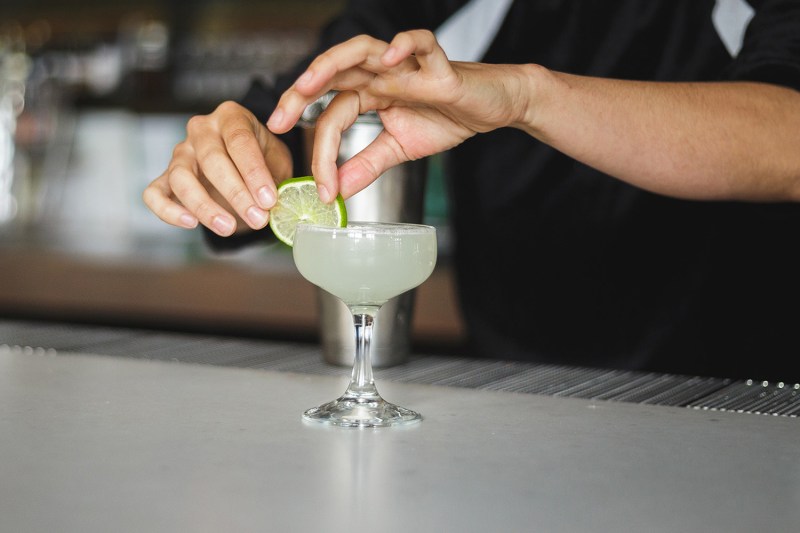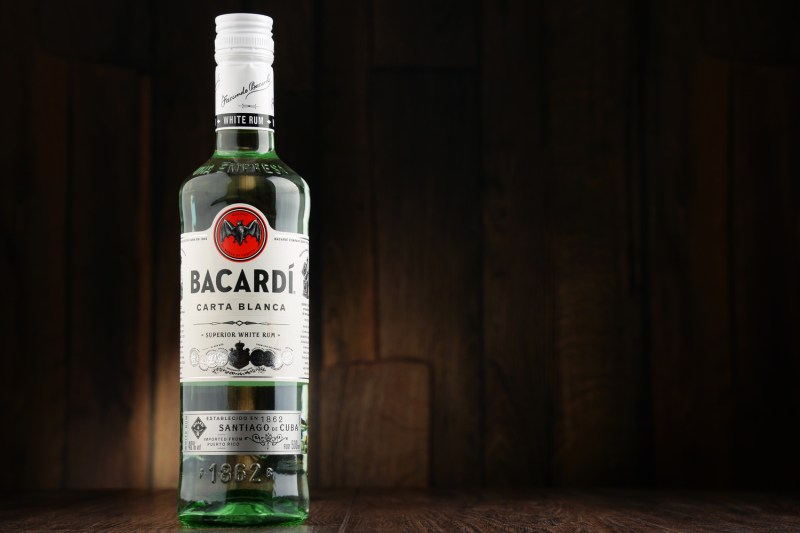
Rum’s importance in the grand history of American drinking stretches back to before the U.S. became a country. Rum was a necessity in the Colonial days, both as an item for trade and as one of the primary means of getting good and wasted. When the country was just getting on its feet, whiskey as we know it hadn’t quite made an impact yet. That left, rum and hard cider and other imports.
Nowadays, rum is crafted in many parts of the globe, with producers employing traditional rum-making methods and a multitude of blending and aging techniques. Given its strong influence in the world, it’s important to know what rum is, how it’s made, as well as the different types of rum that are available out there.

What is rum made from, and how is it made?
Rum is a liquor distilled from sugarcane byproducts — typically sugarcane juice, sugar cane syrup, or molasses, according to Difford’s Guide For Discerning Drinkers. After sugar cane was introduced to the Caribbean by Christopher Columbus, slaves were the main consumers of the molasses created during the sugar production process. Even then, the waste was so abundant that people didn’t know what to do with it until someone finally got the bright idea to make alcohol.
Modern rum is usually made using one of three methods: Directly fermenting sugar cane juice, creating a concentrated syrup from sugar cane juice and fermenting the result, or processing the juice into molasses and fermenting that. The climate and the soil will impact the final taste of the rum, which is why rum produced from molasses from Barbados will taste different than a rum made from Dominican molasses, even if the two were distilled in exactly the same place with the same method. The vast majority of rum distillers use molasses to make rum, but not all molasses is created equally.
“In Britain and the former British colonies, the first distilling is called light molasses, the second dark treacle or dark molasses, while the third is called blackstrap molasses,” wrote Richard Floss in Rum: A Global History. “Rum of varying quality can be made from all of these, though liquor made from the lower grades of syrup is usually re-distilled to remove pungent flavors.”
On the fermentation side of things, distilleries can then choose from a couple of different paths. If they go with natural fermentation, the sugar product will sit in open vats, letting the natural yeasts in the air do their thing and turn the sugar into alcohol. Another option — and one most larger companies use — is to introduce pre-determined strains of yeast themselves and from there, control the fermentation from beginning to end.
Once fermentation has completed, distillers are left with a low-alcohol product (sometimes called the low wines). It isn’t rum yet, but it will be once it goes through distillation, which is the process by which alcohols are separated from the fermented liquid.
The variables in making rum don’t end with fermentation and distillation. After that comes aging (or the lack thereof).
Distillation happens in stills, which are made of copper or steel or typically come in two varieties: continuous or pot. There are other kinds of stills — and variations within each — but those are the two main kinds. Distillers can opt to use one type or the other or some mixture of both. Depending on the type of rum, it may go through the distillation process a second time, raising the alcohol content even higher. As with every other element of the distillation process, the choices here will affect the final taste of the rum.
The variables in making rum don’t end there, though. After distillation comes aging (or the lack thereof). Distillers can choose to put out an unaged product or they can pump it into barrels for a length of time (sometimes as little as a few weeks and sometimes as much as 20 or 30 years). And all of those variables lead to many different kinds of rum.

Types of rum
White rum
You know this one from a mojito, popular Caribbean swizzles, or most drinks that are served with an umbrella. White — also known as light or silver — rums are the lightest in flavor and are typically aged three to six months in tropical climates or up to one year in colder climates. Unlike other rums, white varieties are distilled in stainless steel casks, thus they tend to offer the most straightforward rum experience. (Check out our pick for the best white rum made in America.)

Gold rum and aged rum
These two types of rum will look very similar, but it’s important that you know which one you’re getting. An aged rum will have a golden or amber hue naturally cultivated from the casks it was made in. There are also a few aged dark rums available. A gold rum can also be aged, but it often gleans its color from additives.
“It is common for caramel to be added to aged rums to ‘correct’ the color, and let’s be honest, often to darken the color so potentially giving the rum an older appearance,” says Difford’s Guide. “Conversely, some aged rums are charcoal filtered to remove any color and are bottled completely clear.”
In terms of taste, an aged rum will have more depth while a gold rum offers a smoother experience with a little more to talk about than a white rum. Here is our pick for the best aged rum made in America.

Dark rum
Remember when we talked about molasses? Here’s where things get heavy. Most dark rums are the result of double distillation and they tend to have the most in common with Scotch or brandy. A third distillation yields blackstrap rum, a deep rum with complex flavors. Regardless of the grade of your dark rum, you should really sip it and can even approach drinking it similarly to whiskey.

Spiced rum or flavored rum
Primarily used in rums made from molasses or sugarcane syrup, the method of flavoring rum with spices or tropical ingredients — like coconuts –has grown increasingly popular. The flavor can either amplify the sweetness of a rum or add heat and complexity. Low-proof liqueurs and alcoholic syrups like rum creams or falernum can be considered subsets of this category.

Rhum agricole
Rhum agricole is made from sugar cane juice, not molasses, and is only produced in the French Caribbean. Rhum production must adhere to the strictest regulations of any rum type, down to the distillation length, making it the most consistent form. Similarly to white rum, the sweetness from the sugar cane comes through in a strong way, but rhum also presents a pleasant grassiness.

Cachaça
Another rum made directly from sugar cane juice, cachaça gained some popularity in the U.S. following the 2016 Olympics. Like Rhum Agricole, cachaça is location-dependent and can only be made in Brazil, though with less stringent rules. As long as the rum is less than 54% ABV and doesn’t use molasses, it can be considered cachaça. Known for its exceptionally sweet sugar cane crop, Brazil’s other rums and cachaça are widely accepted as the sweetest and most palatable rums in production.

Overproof
Are you feeling hot, hot, hot? Commonly used for

Classic rum cocktail recipes
Now that you’ve learned about rum, it’s time to mix some cocktails. Here are a couple of classic rum cocktail recipes that any amateur mixologist should know.
Daiquiri
This is one of the quintessential rum cocktails. According to Liquor.com, the daiquiri was supposedly invented in the Cuban mining town of, you guessed it, Daquiri, by an American mining engineer.
Ingredients:
- 2 ounces light rum
- 1 ounce freshly squeezed lime juice
- 3/4 ounce demerara sugar syrup
- Lime twist
Method:
- Add rum, lime juice, and sugar syrup to a cocktail shaker with ice and shake until it’s well chilled.
- Strain into a chilled coupe glass.
- Garnish with a twist of lime.

Piña colada
One of the first
Ingredients:
- 2 ounces light rum
- 1 1/2 ounces cream of coconut
- 1 1/2 ounces pineapple juice
- 1/2 ounce freshly squeezed lime juice
Method:
- Add rum, cream of coconut, lime juice, and pineapple juice to a cocktail shaker with ice and shake for 20 to 30 seconds.
- Strain into a chilled hurricane glass.
- Garnish with a wedge of pineapple.

Mai Tai
The history of the Mai Tai is a bit of a muddled concoction itself, with several competing claims to its origin. Victor J. Bergeron, known as Trader Vic, claimed to have invented the Mai Tai in 1944 at his Trader Vic’s restaurant in Oakland, California. Ernest Raymond Beaumont-Gantt, owner of Don the Beachcomber bar in Hollywood, claimed to have created the Mai Tai in 1933. Some speculate the Mai Tai evolved from punch served at Don the Beachcomber that Trader Vic enjoyed. Others believe the name was inspired by an existing Tahitian drink.
No matter what, the Mai Tai is a classic rum cocktail with a tropical twist, and there are many variations on the recipe. Here’s a popular version.
Ingredients:
- 1 1/2 ounces white rum
- 3/4 ounce orange curaçao (or Grand Marnier)
- 3/4 ounce fresh lime juice
- 1/2 ounce orgeat syrup
- 1/2 ounce dark rum (for floating)
- Lime wedge, mint sprig
Method:
- Combine white rum, curaçao, lime juice, and orgeat syrup in a shaker with ice.
- Shake well for about 30 seconds.
- Strain into a rocks glass filled with fresh ice.
- Slowly pour the dark rum over the back of a spoon to float it on top.
- Garnish with a lime wedge and mint sprig.



